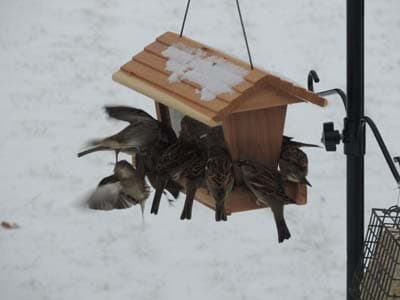Feeding Birds in Your Backyard

About Feeding Birds
Feeding birds is fun and rewarding. First, let’s begin with the basics. Rest assured there is no right or wrong way to feed wild birds. All it takes is a little bread or birdseed in the palm of your hand, and you’re in the business of feeding chickadees. However, for most other birds three’s a wide variety of seeds and bird food. Also, you will find an endless selection of bird feeders on the market. Importantly, strategically place them to maximize your viewing pleasure and enjoyment.
Feeding Birds - Types of Food
The diet of each type of bird varies. Some birds only eat only seeds, and perhaps bread. They may be picky about the type of seeds they eat. Other birds eat mostly insects and bugs. Meanwhile, some birds eat seeds, insects, and bugs.
If you want to attract and feed any birds that are in your area, a bird feeder with a mixed variety of seeds will make you a happy bird watcher. However, to attract a particular variety of birds, learn the diet of that specific bird.
Feeding Birds with Birdseed
Here are the basic types of bird seeds:
Seeds and their value to Birds:
| Sunflower | High in protein and fats | |
| Black Sunflower | High in oil. | |
| Sunflower Kernel | High in energy | |
| Cracked Corn | carbohydrates, grit to grind seeds. | |
| Safflower | High in oils, but only certain birds will eat it. | |
| Peanut Kernels | High in fat and calories | |
| Thistle (Nyger) | High in oil. A favorite of finches. | |
| Yellow Millet | Vitamins, and protein | |
Bird Feeding Reference Chart – See what your favorite birds like to eat.
Note: Opportunistic squirrels like most seeds. too. Safflower is an exception. Too bad only a few birds eat Safflower.
A misnomer: What many of us call Thistle is actually Nyger.
Feeding Birds Bread
It is a very common practice to feed bread to birds. Many varieties of birds will eat the bread. In most situations, it is a good addition to a bird’s diet. But it is not and should not be their entire diet. Seeds, insects, and grubs are all vital to specific birds. Additionally, seeds provide the high energy that birds require for survival in cold, snowy weather.
Importantly, if you are going to feed bread to your neighborhood birds in winter, make sure to have the bird feeder filled with seeds, too.

Other Common Bird Food
Suet is high in energy, and fat. Feed your birds suet during cool weather and winter months. Suet is fat and melts in warmer weather. It becomes rancid and spoils. This is dangerous to your birds. Therefore, discontinue using suet when high temperatures reach 70 F degrees.
Vegetable treats – Peas, corn, and other seeded vegetables.
Berry bushes – Blackberries, raspberries, blueberries. Almost any berry plant or bush will attract a variety of birds.
Flying insects are a favorite of many birds, including purple martins, bats, and many more.
Worms and grubs – in your soil and lawn. Just skip the grub killer one season and you will attract a lot of birds.
Feeding Birds - Providing Grit and Stones
As you know, backyard birds do not have teeth. They need grit in their gizzard to help grind down the seeds they eat. In the winter, it may be hard for them to find the grit they need. Thus, you can help by placing coarse sand near the bird feeder. If you leave it out, they will find it.
Did you know? Eggshells aid birds in digesting food. Crush a few dried eggshells and leave them at or near the feeder, especially in winter when it is hard for birds to find tiny pebbles and grit.
Garden Flowers for Birds
Gardeners, birds feed on the seeds of many flowers. Here are some flowers that you can grow that will attract birds to your yard:
- Amaranths
- Orach
- Aster
- Bachelor Button
- Goosefoot
- Thistle, any variety
- Cosmos
- Delphinium
- Purple Coneflower
- Blanketflower
- Sunflower
- Salvia
- Hyssop
- Flax
- Alyssum
- Poppy
- Black-Eyed Susan
- Pincushion Flower
- Zinnia
- Trumpet Vines
- Sorghum
- Millet, all kinds
Types of Bird Feeders
Bird Feeders- There are different bird feeders for different types of birds. Hanging feeders and platform feeders. Specialized bird feeders to hold different kinds of seed and attract different types of birds.
Birds can become dependent upon your feeder. The toughest time for a bird to find food is mid-winter when snow covers their food supply, and spring when natural food supplies are low or exhausted. Once you start feeding the birds, it is best to continue to do so until summer, when natural food is plentiful.
Importantly, bird feeders should be cleaned regularly. If not, molds and disease can build up, harming or even kill your birds. Clean bird feeders regularly, with warm, soapy water.
Did you Know? Some birds feed upside down, so the bird’s perch and feeding station need to be placed accordingly.
More on Birds
Learn About Other Birds
Please support our site. Shop for:

- rmmatthews100@hotmail.com
- 585-721-6528
- Rochester, NY
©1999-2024 GardenersNet.Com, All Rights Reserved

